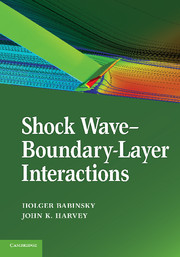Book contents
- Frontmatter
- Brief Contents
- Contents
- Contributors
- 1 Introduction
- 2 Physical Introduction
- 3 Transonic Shock Wave???Boundary-Layer Interactions
- 4 Ideal-Gas Shock Wave???Turbulent Boundary-Layer Interactions (STBLIs) in Supersonic Flows and Their Modeling: Two-Dimensional Interactions
- 5 Ideal-Gas Shock Wave???Turbulent Boundary-Layer Interactions in Supersonic Flows and Their Modeling: Three-Dimensional Interactions
- 6 Experimental Studies of Shock Wave???Boundary-Layer Interactions in Hypersonic Flows
- 7 Numerical Simulation of Hypersonic Shock Wave???Boundary-Layer Interactions
- 8 Shock Wave???Boundary-Layer Interactions Occurring in Hypersonic Flows in the Upper Atmosphere
- 9 Shock-Wave Unsteadiness in Turbulent Shock Boundary-Layer Interactions
- 10 Analytical Treatment of Shock Wave???Boundary-Layer Interactions
- Index
- References
9 - Shock-Wave Unsteadiness in Turbulent Shock Boundary-Layer Interactions
Published online by Cambridge University Press: 05 June 2012
- Frontmatter
- Brief Contents
- Contents
- Contributors
- 1 Introduction
- 2 Physical Introduction
- 3 Transonic Shock Wave???Boundary-Layer Interactions
- 4 Ideal-Gas Shock Wave???Turbulent Boundary-Layer Interactions (STBLIs) in Supersonic Flows and Their Modeling: Two-Dimensional Interactions
- 5 Ideal-Gas Shock Wave???Turbulent Boundary-Layer Interactions in Supersonic Flows and Their Modeling: Three-Dimensional Interactions
- 6 Experimental Studies of Shock Wave???Boundary-Layer Interactions in Hypersonic Flows
- 7 Numerical Simulation of Hypersonic Shock Wave???Boundary-Layer Interactions
- 8 Shock Wave???Boundary-Layer Interactions Occurring in Hypersonic Flows in the Upper Atmosphere
- 9 Shock-Wave Unsteadiness in Turbulent Shock Boundary-Layer Interactions
- 10 Analytical Treatment of Shock Wave???Boundary-Layer Interactions
- Index
- References
Summary
Introduction
If the shock wave associated with a shock wave–boundary-layer interaction (SBLI) is intense enough to cause separation, flow unsteadiness appears to be the almost-inevitable outcome. This often leads to strong flow oscillations that are experienced far downstream of the interaction and can be so severe in some instances as to inflict damage on an airframe or an engine. This is generally referred to as “breathing” or, simply, “unsteadiness” because it involves very low frequencies, typically at least two orders of magnitude below the energetic eddies in the incoming boundary layer. The existence of these oscillations raises two questions: “What is their cause?” and “Is there a general way in which they can be understood?”
There are several distinct types of SBLIs, depending on the geometry and whether the flow separates, and it is possible that these create fundamentally different types of unsteadiness. An interpretation was proposed by Dussauge [1] and Dussauge and Piponniau [2] using the diagram reproduced in Fig. 9.1. The organization of the diagram requires comment: In the upper branch, unseparated flows are depicted; those that separate are restricted to the lower branch. In both cases, the shock wave divides the flow into two half spaces: the upstream and the downstream layers. Hence, the shock wave can be considered an interface between the two conditions and its position and motion vary accordingly. With these various elements in mind, the shock motion can be analyzed from the perspective of the upstream and downstream conditions. The discussion in this chapter is a commentary about flow organization and other phenomena related to the two branches of the diagram.
Information
- Type
- Chapter
- Information
- Shock Wave-Boundary-Layer Interactions , pp. 373 - 394Publisher: Cambridge University PressPrint publication year: 2011
References
Accessibility standard: Unknown
- 4
- Cited by
